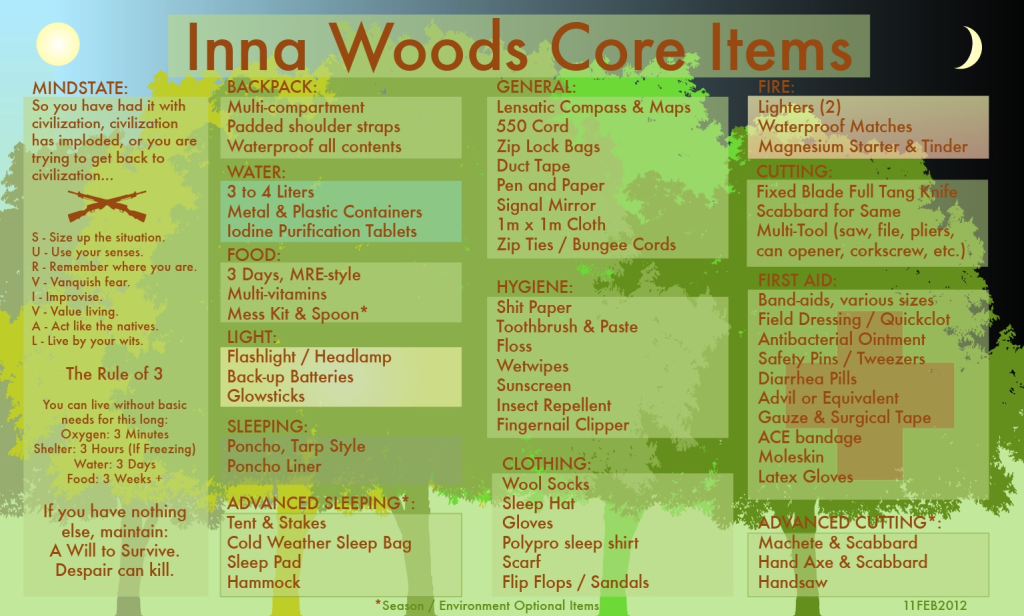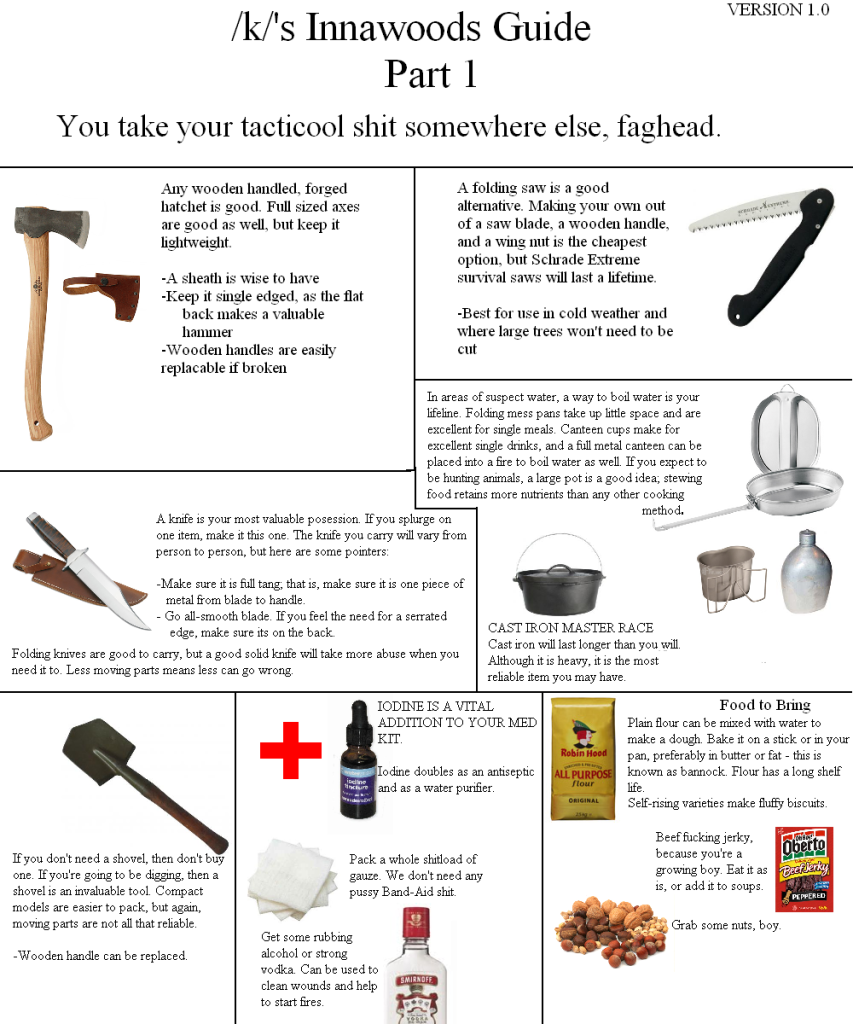This is the second entry in our preparedness series. Our intention with this article is to discuss sustainment equipment, which is often overlooked in prepper circles. The first article discussed your skills and mindset as the foundation, sustainment gear is the second level of this structure. A gun is very useful, but not if you are starving or succumb to exposure. The purpose of this article is to mostly discuss the meta approach to how you select your gear, not to give particular suggestions in terms of kinds of gear or brands which are easily accessible from other sources.
Before we get into the meat of this topic, it is important to understand that you should always have an escape plan, but you should focus on bugging in. Be prepared to drop everything and hit the road, but the main focus of your preparation should be living in a strategically sound location with ample supplies and sources to survive as long as this is viable. Skills like gardening or carpentry are always great, as was mentioned in the first article. Ideally you will have a community and home ready for hard times.
The reason we set out to write this article were a few criticisms of common misconceptions in the prepper community. The largest of these are copying everything the military does and a focus on high speed low drag tactical training. Many people copy one to one what the military does. You are not in the military. Even the largest militia groups in the country do not have the infrastructure, logistical capabilities, and resources to support your activity in the way a modern military does. You will not have mechanized logistics to drive you around with one hundred pounds of gear, you will not have helicopters to pull you out of combat with an injury, and you will not have an easy ability to resupply or to disengage. You need to structure your gear around being a lone recon-like force, you are a guerilla not a marine infantryman.
Some of the common mistakes which stem from copying the military are what resulted in the need for this article. They include things like spending thousands of dollars on night vision goggles which you likely have no means to maintain or charge in your current position; emphasis on wearing body armor which weighs you down, limit your mobility/dexterity, and make you more vulnerable to hot weather; and a focus on modelling your gear set up on SWAT teams who clear rooms in very limited circumstances (an example of this being the recent trend of short barrel rifles).
The common trend in the above is the exact core problem mentioned: it all models off of the military. People pretend to be a marine or a navy seal. Both of these positions rely on effectively unlimited resources. An FBI member does not have to have his kit sustain him for days or weeks at a time, a marine will almost always have access to his logistical supply chain, and a Navy SEAL operates with near impunity against smaller forces whilst having near unlimited resources behind him. Almost none of this applies to anyone in our future situation, you are better off modelling yourself off their adversaries than them. When the dominoes begin to fall, their supply lines and general apparatus will be put under extreme stress, which will give us an advantage over them if we use the correct strategy, as outlined here.
The most important aspects of sustainment are not shelling out thousands of the dollars on top of the line gear, but having quality gear you know how to use in an environment you are familiar with. Without knowledge of your local area, where to get food water, where to hunt, dangerous places and people, military/police locations, and the location of other valuable resources you will not survive with the greatest gear. The topics of map making and area surveying will be discussed in a future article.
In addition to knowledge, experience is equally important. Buying new pieces of kit every week won’t do you any good if you don’t practice with it and test it. You should be breaking in your boots, going on hikes, camping, seeing how these things work for you and how to adjust your system. Your gear is only as good as the person using it, no matter the cost as they are tools not solutions. In addition to this, if you are out of shape or don’t know how to survive your gear will be picked from you like meat from the bones of roadkill.
Additionally, you should understand the limitations of your skill set and gear. Outside of the best survivalists in the world, even many experiences outdoors-men couldn’t survive long term out of a hundred liter rucksack for more than a week or so. You need to have a plan on where exactly you are bugging out to. In the great depression the North American deer population was nearly wiped out, many other people will have the same idea you do. You need to have a specific location or series of locations in mind as a backup plan if your primary residence becomes untenable.
Utilizing all of the above, you need to design a system built around your circumstances and environment. There is no simple gear checklist we can provide to you which cover everyone’s situation. A radical in Alaska will have a huge disparity in needs compared to someone from Louisiana or Appalachia. It is your job to do your own research and have an understanding of what is necessary for you in your unique situation.
The system you design ought to have some of the following characteristics in mind.
Most camping equipment falls into two major categories: stuff intended for casual campers and stuff intended for enthusiasts. You average Coleman tent is not meant for anything more than camping out at a music festival or a boy scout camping 30 yards away from his dad’s car. The enthusiasts gear offers way better options, although there are some set backs due to modern trends. A ultra-light backpacking tent will weight nearly half as much as a ‘casual’ tent while being easier to pack. There has been a recent trend towards gear as light as possible which should be taken advantage of. This falls in line with the military comparison, the Coleman tent relies on your logistical access to make it viable while a backpacking tent is meant to make you as mobile and light as possible. This example is one of many in comparing how these markets differ.
That being said, most modern equipment is exactly that- modern. Modern stuff is not built to be as easily repaired or sustainable as the gear in the days of our ancestors. A sleeping bag if damaged enough will not be able to be repaired in the field like a wool blanket can. Another example is comparing a modern fiberglass/plastic handled axe to an old wooden one, the old one is heavier but offers the ability for you to make and replace your own handle. You need to keep things like this in mind, as the situation we face will mean you will not have access to a company’s “good warranty” or replacement parts. There should be a balance, keep things simple and sustainable while also taking advantage of modern technology.
You also do not have to shell out for the latest and greatest, there are plenty of deals to be had for mid level gear or military surplus which will likely fulfill most of your needs.




